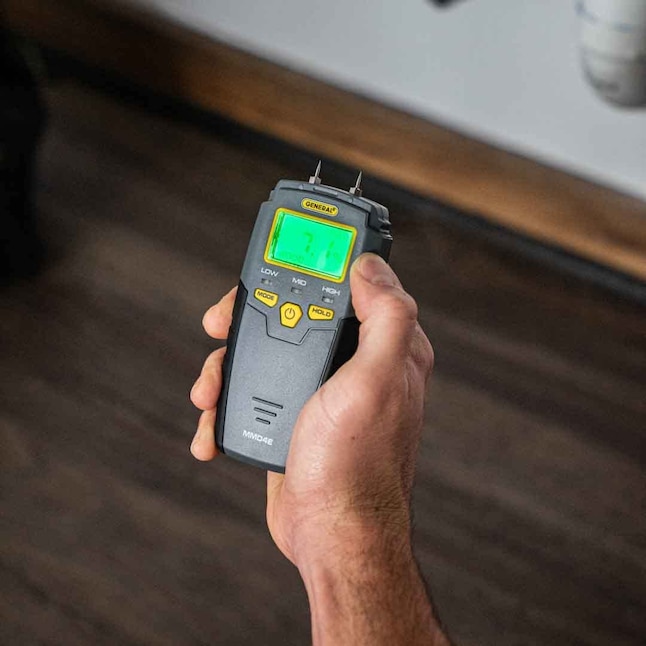Moisture Meter Acquiring Overview: What to Seek in High-Quality Instruments
Moisture Meter Acquiring Overview: What to Seek in High-Quality Instruments
Blog Article
Comprehending the Significance of a Moisture Meter in Protecting Against Mold and Water Damages in your house
In the world of home upkeep, the presence of moisture can usually be a silent yet powerful foe, qualified of creating pervasive mold growth and perilous water damages if left uncontrolled. Comprehending the significance of a wetness meter in this fight is not merely a choice yet a calculated need.
Importance of Moisture Detection
Efficient moisture detection techniques are important for guarding residential properties and protecting against possible mold and mildew development and water damages. Dampness can permeate right into numerous structure products, causing structural problems and carcinogen. By using a wetness meter, property proprietors can proactively recognize locations vulnerable to excess wetness, enabling prompt treatment and reduction strategies.
Moisture meters supply precise readings of wetness degrees in different materials such as concrete, drywall, and wood. This data aids in determining areas of concern, also in hard-to-reach or covert places. Early discovery of moisture buildup allows punctual repair services or modifications to prevent more damage.

How Moisture Meters Job
Dampness meters play an essential function in the positive identification of excess dampness, helping in the prevention of prospective mold growth and water damages by giving exact readings of moisture levels in various structure products. These tools function based on various principles, depending on their type. Moisture Meter. Pin-type dampness meters, for example, have two pins that permeate the material to gauge the electrical resistance between them. When wetness is present, it boosts the product's conductivity, causing a lower resistance reading. Pinless wetness meters, on the various other hand, use electro-magnetic sensing units to scan the material without creating damages. These sensors emit electromagnetic signals that pass through the product and measure the dielectric residential or commercial properties, suggesting dampness content. Some advanced wetness meters incorporate both pin and pinless innovations for comprehensive wetness discovery. Recognizing how moisture meters feature is essential for precise and timely wetness level analyses, allowing efficient precautionary steps against mold and mildew and water damage.
Finding Early Caution Signs
Upon preliminary examination of a building, acknowledging subtle signs of excess wetness ends up being essential in the very early discovery of possible mold growth and water damage. Some common very early indication consist of stuffy smells, water spots on ceilings or walls, peeling paint or wallpaper, and distorted or blemished surface areas. Stuffy smells typically suggest the visibility of mold and mildew or mold, also if no visible indications are apparent. Water stains can signify leaks or seepage, while peeling off paint or wallpaper may be an outcome of dampness endangering the bond of these materials to the surface area. Deformed or blemished surfaces, such as buckling floorboards or blemished drywall, are clear indications of water damage. Additionally, a boost in allergy symptoms or respiratory problems amongst owners might suggest the visibility of mold and mildew because of excess moisture. By immediately identifying and resolving these early indication, property owners can minimize the risk of substantial mold and mildew growth and water damage in their properties.
Protecting Against Mold And Mildew Development
Identifying very early warning indications of excess wetness within a building not just makes it possible for prompt discovery of possible mold growth and water damage but likewise acts as a proactive action in preventing the spreading of mold and mildew. To properly stop mold growth, it is crucial to resolve any kind of sources of dampness immediately. This can include fixing leakages in windows, roof coverings, or pipelines, making sure correct ventilation in wet areas like cooking areas and washrooms, and utilizing dehumidifiers in high-humidity areas. On a regular basis inspecting and preserving the home's pipes, roofing, and rain gutters can likewise assist in stopping water invasion that could bring about mold and mildew growth.
Along with dealing blog with moisture sources, keeping indoor humidity levels listed below 60% can significantly inhibit mold development. Correct air flow, special info adequate insulation, and using air conditioning unit or followers can aid control interior humidity degrees. Checking moisture degrees in areas vulnerable to dampness, such as cellars and creep spaces, using a moisture meter can likewise help in early detection of raised wetness levels and prospective mold growth. By taking aggressive actions to prevent excess dampness and mold and mildew growth, property owners can secure their property and interior air high quality.
Benefits of Normal Tracking
Regular tracking of dampness levels in a property can play a vital role in preserving a healthy and balanced indoor atmosphere and stopping possible mold and water damages. By routinely inspecting moisture levels, house owners can detect any concerns quickly and take necessary actions to protect against mold and mildew development and water damages.
Furthermore, normal surveillance enables homeowners to track patterns and trends in wetness levels gradually. By developing a baseline and surveillance modifications, people can recognize any type of areas of concern or prospective vulnerabilities in the residential or commercial property's structure. This data-driven strategy makes it possible for targeted interventions and maintenance efforts to resolve underlying concerns before they rise right into more substantial issues. Eventually, the consistent surveillance of wetness levels encourages home owners to shield their residential or commercial property, safeguard their health, check that and preserve the integrity of their interior atmosphere.

Conclusion

By making use of a wetness meter, residential or commercial property owners can proactively recognize locations vulnerable to excess dampness, allowing for prompt intervention and mitigation strategies.

Keeping an eye on dampness degrees in locations vulnerable to dampness, such as basements and crawl areas, making use of a moisture meter can also aid in early detection of raised dampness degrees and potential mold and mildew development. (Moisture Meter)
Report this page